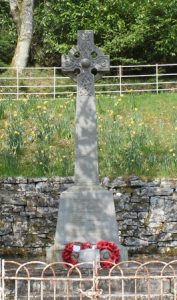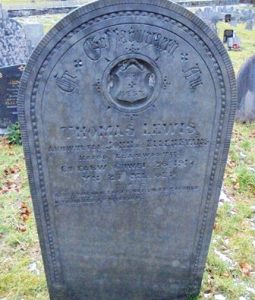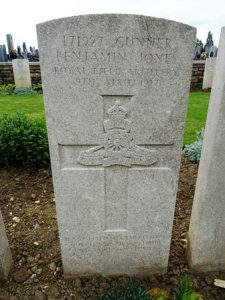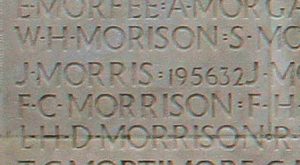Llanwddyn is a village situated around Lake Vyrnwy dam. The original Llanwddyn village, about two miles northwest, was submerged when the reservoir was created in the 1880s to create a water supply for the city of Liverpool. As part of the project to erect the dam and create the reservoir, the city of Liverpool built a new Church to replace the ancient one which was lost as a result of the project, and this new Church was dedicated to Saint Wddyn. The wider community of Llanwddyn includes the village of Abertridwr. The men of Llanwddyn who fell during the Great War are commemorated on a war memorial which is situated to the north side of the road from Abertridwr to Lake Vyrnwy, near the side road to St Wddyn’s church. The memorial takes the form of a Celtic Cross, standing on a pedestal upon which the names of the fallen are engraved. The memorial also commemorates, but does not name, the 55 NCO’s and men, and one woman from the village who served and survived.

The Great War, 1914-1918
Ralph Bennett, Second Lieutenant, Worcestershire Regiment. Ralph was born at Redditch, Worcestershire in 1897, the son of Ralph Bennett and Florence May Bennett (nee Banks). The family later bought the Lake Vyrnwy Hotel, at Llanwddyn. Ralph enlisted into the Royal Fusiliers soon after the outbreak of war, and had served in France from the summer of 1916, being promoted to Sergeant before gaining a commission as Second Lieutenant into the Worcestershire Regiment on 28 April 1918. Ralph was then posted to the 10th Battalion, Worcestershire Regiment, but in August 1918 was attached to the 1st Battalion, Herefordshire Regiment, which was attached to 102 Brigade, 34th Division. The Division had suffered heavy casualties during the Spring of 1918 and had been reduced to a training cadre, before moving back into the line in June 1918. This is when the 1st Herefords joined the Division, having been transferred to France from Palestine that month. Ralph joined the battalion in Divisional Reserve at Siege Camp, near Proven, where it was carrying out a system of training, before it moved to the St. Omer area with the Division at the end of the month. The Division then moved to the Scherpenberg sector, taking over the front line by 2 September. On 4 September 1918 the Herefords launched an assault against the Germans facing their positions, but failed to attain the objectives due to uncut barbed wire. Ralph was killed in action during the failed attack that day. The 21-year-old has no known grave and is commemorated on the Tyne Cot Memorial, Belgium.
Walter Butt, Private, 13576, Royal Fusiliers. Walter was born in Llanwddyn in 1888, the son of Walter Butt and Mary Ann Butt (nee Wilson). His mother had died in 1899, and his father had moved his family to Bradfield, Yorkshire. Walter lived at Barnacre Moor, Garstang prior to the war, where he worked as a labourer. He enlisted at Sheffield into the 25th Battalion, Royal Fusiliers soon after the outbreak of war. The battalion had been raised in London by the Legion of Frontiersmen on 12 February 1915, and on 10 April embarked at Plymouth for East Africa, arriving at Mombasa on 4 May. By the summer of 1917 Walter had left East Africa, and was posted to the 4th Battalion, Royal Fusiliers on 24 July 1917, but on 9 September 1917 was transferred to the 8th Battalion, Royal Fusiliers. The battalion was attached to 36 Brigade, 12th (Eastern) Division, and was in the Arras sector. Walter joined the battalion near Monchy, where it was holding the Wancourt-Feuchy line. On 17 July the battalion was relieved and moved to Achicourt, to begin a training scheme, returning to the Monchy sector nine days later. By 19 November the Division had moved to Gonnelieu, and on the following day, 20 November 1917, launched its assault against the Hindenburg Line, as part of the opening attacks of the Battle of Cambrai. Walter’s battalion saw heavy fighting over the coming days, before being relieved on 25 November, and enjoyed a short rest before moving back into the front line at Pelican Trench on 29 November. On the following morning, 30 November 1917, the Germans opened up a murderous artillery barrage along the British lines, before launching a powerful counter-attack. Walter was killed in action during the heavy fighting which followed that day. The 29-year-old has no known grave and is commemorated on the Cambrai Memorial, Louverval, France. Walter is not commemorated on the Llanwddyn war memorial.
David Watkin Davies, Private, 355317, Royal Welsh Fusiliers. David was born at Pennant in 1896, the son of David Davies and Tabitha Davies (nee Watkins). His father had died by 1901, and his mother re-married Thomas Jones, of Tanyfron, Llanwddyn. David was raised by his grandmother at Felin Fach, Penybontfawr. He enlisted into the Montgomeryshire Yeomanry at Penybontfawr. The Montgomeryshire Yeomanry had been mobilised at Welshpool soon after the outbreak of war, as part of the South Wales Mounted Brigade, before moving via Hereford to Thetford, to join the 1st Mounted Division. On 4 March 1916 the 1st Mounted Division sailed for Egypt to join the EEF. On 4 March 1917 the battalion merged with the Welsh Horse Yeomanry to form the 25th (Montgomery & Welsh Horse Yeomanry) Battalion, Royal Welsh Fusiliers, as part of the newly formed 231 Brigade, 74th (Yeomanry) Division. The Division assembled in Egypt as part of the EEF, before crossing the Suez Canal into the Sinai, and saw its first major action during the Second Battle of Gaza. The battle was a failure, and the EEF was re-organised under a new commander, Sir Edmund Allenby, before launching the Third Battle of Gaza on the night of 31 October 1917. This assault was launched along a winder front, running from Gaza to Beersheba, and this time the EEF prevailed, opening the door to Jerusalem. The Division then took part in the drive north into Syria, but as a result of the heavy losses suffered in France, following the launching of the three German Spring offensives from 21 March 1918, was sent to France, landing in Marseilles on 7 May 1918. The Division underwent a system of training, to prepare it for the vastly different conditions on the Western Front, before taking over a section of the front in the St. Floris Sector. In September the Division moved south to the Somme sector, to join the great Allied offensive towards the Hindenburg Line, and on 18 September took part in an assault on positions near Lempire and Ronssoy, which formed part of the outer defensive line for the Hindenburg Line. After suffering heavy casualties, especially around Orchard Post and Gillemont Farm, the Division then attacked the Quadrilateral defences, suffering heavily again before being relieved on 24 September and entrained at Péronne for northern France once more. David had been wounded during the fighting for Orchard Post, and was evacuated to Hospital at Le Havre, where he died of his wounds on 25 September 1918. The 23-year-old is buried in Ste. Marie Cemetery, Le Havre, France.
Thomas Lewis Evans, Private, 203782, Royal Welsh Fusiliers. Thomas was the son of John and Ellen Evans, of Hafod, Llanwddyn. He worked as a Shepherd for Thomas Thomas at Amnodd Wen, Bala prior to enlisting at Dolgellau into the 4th Battalion, Royal Welsh Fusiliers on 1 February 1917, and was posted to Wrexham, before joining the 4th Reserve Battalion at Park Hall, Oswestry. Within seven weeks of arriving at the camp, Thomas was taken ill, and he died of bronchitis at Park Hall Hospital, Oswestry on 25 February 1917, aged 26. His remains were brought home for burial in St. Wddyn’s Churchyard, Llanwddyn.

Thomas Richard Evans, DSO, Lieutenant-Colonel, North Staffordshire Regiment. Thomas was the son of Hugh and Mary Evans, of Llanwddyn. He was educated at Trawsfynydd School before gaining his BA in the University of London and afterwards worked for the Civil Service in London. Whilst in London he gained a reputation as a poet and playwright, and had won three Bardic Chairs prior to the war. Thomas married Hirall Catherine Douglas Young, in 1907, and the couple lived at 13, Victoria Road, Dagenham, Romford, Essex. He enlisted into the Royal Welsh Fusiliers soon after the outbreak of war and gained his commission into the Regiment, helping to raise recruits for the regiment in London. Thomas soon rose through the ranks and by April 1917 was promoted to Lieutenant-Colonel, taking command of the 1/6th Battalion, North Staffordshire Regiment in June 1918. The battalion was in the Essars sector, attached to 137 Brigade, 46th (North Midland) Division. On 8 August 1918 a brilliant Allied victory at Villers Bretonneux broke German spirits, then on 21 August a general advance was launched along the Western Front. The 46th Division, commanded by a Welshman, John Vaughan Campbell, VC, DSO, moved to Heilly, in the Somme valley, two weeks later, to take part in the great offensive, relieving the Australian Corps, and on 29 September 137 Brigade launched its famous attack on the Hindenburg Line, capturing the Riqueval Bridge across the St. Quentin Canal. The event is regarded as among the finest feats of arms of the entire war. The Division rested at Bellenglise before advancing again, and on the morning of 3 October 1918 Thomas led his battalion into an attack on the Fonsomme Line, near Levergies, with the assistance of tanks. The battalion successfully captured its objectives, together with some 2,000 prisoners, but Thomas was killed in action during the afternoon. He was 34 years old and is buried in Bellicourt British Cemetery, France. Thomas was posthumously awarded the Distinguished Service Order. Thomas is not commemorated on the Llanwddyn war memorial, but at Trawsfynydd.

Edward Herbert Gittins, Corporal, 23008, The King’s (Liverpool Regiment). Edward was the son of Ellis Gittins and Mary Gittins (nee Jones), of Brynanna, Llanwddyn. He worked as a Tailor prior to enlisting at Liverpool into the 20th Battalion, The King’s (Liverpool Regiment) soon after the outbreak of war. The battalion had been raised in Liverpool by Lord Derby on 16 October 1914, moving to Tournament Hail, Knotty Ash and then Knowsley Park, then on 30 April 1915 moved to Belton Park, Grantham to join 89 Brigade, 30th Division. The Division embarked for France on 7 November 1915, and moved to the Somme sector. Edward was wounded early in 1916, and returned home, marrying Elizabeth Roberts, of 152, High Street, Bangor whilst on leave that Spring, and their son, Oliver, was born on 7 June that year. In May 1917 he returned to France, joining the 13th Battalion, The King’s (Liverpool Regiment), which was attached to 9 Brigade, 3rd Division. The Division was in the Arras Sector, and had suffered heavy casualties whilst taking part in the Battle of Arras during the previous weeks, before being relieved on 18 May and moving to rest billets in Beaufort. On 1 June Edward’s new battalion moved back into the line, and began work on consolidating and improving trenches. This work was carried on, in addition to the usual routines of trench rotation, over the coming weeks, before the Division was relieved at the beginning of September, and moved to Beaulencourt to carry out a programme of training, before entraining for the Ypres Salient on 18 September. The Division was then thrown into action during the Passchendaele offensive, taking part in the Battle of the Menin Road and the Battle of Polygon Wood, before being moved south again in October, to take part in the Battle of Cambrai. On 11 December the 13th Liverpool’s moved into the front line in the Noreuil Sector, and on the following morning, 12 December 1917, came under artillery fire before being hit by the German counter-attack. Edward was killed in action during the fighting that day. The 26-year-old was buried in Favreuil British Cemetery, France.
Benjamin Jones, Gunner, 171927, Royal Field Artillery. Benjamin was born in Llanrhaiadr in 1884, the son of Benjamin Jones and Maria Jones (nee Hughes). He married Charlotte Jane Evans in 1907 and the couple lived at Llanwddyn for several years before moving to Bryn Aber, Llangadfan, where Benjamin worked as a labourer. He enlisted into the Royal Field Artillery at Llanfyllin, and after completing his training was posted to France early in 1917, joining X/5th Trench Mortar Battery, Royal Field Artillery. The Battery was attached to the 5th Division, and was holding the line near Festubert, where it was rebuilding following heavy losses on the Somme the previous year. In March the Division transferred to the Arras sector, moving to Vimy, and the Trench Mortar Batteries were at work constructing gun pits, in preparation for the forthcoming Canadian assault on Vimy Ridge, where their main duties would be in cutting the enemy wire defences. Benjamin was most probably wounded when the gun teams came under artillery fire during the opening days of April, and he died of his wounds soon after, on 9 April 1917. The 32-year-old is buried in Barlin Communal Cemetery Extension, France.

Thomas Jones, Gunner, 77065, Royal Garrison Artillery. Thomas was the son of Henry and Sarah Jones, of Gadfa, Llanwddyn. He worked as a Gamekeeper prior to enlisting into the Royal Garrison Artillery at Welshpool on 21 February 1916, and was initially placed on the Army Reserve. Thomas was mobilised on 4 May 1916 and sent to For Brockhurst, Gosport for training. He embarked at Folkestone on 25 October 1916, landing at Boulogne that same day, and was posted to the 186th Siege Battery, Royal Garrison Artillery. Thomas joined the Battery on the Somme, in its positions at Sailly-au-Bois, where it was attached to the 42nd Heavy Artillery Group, supporting the Somme offensive. At the beginning of April 1917, the Battery moved to the Bullecourt Sector, to take part in the forthcoming Arras offensive, and supported the assault on the Hindenburg Line at Bullecourt. Thomas was badly wounded on 7 May 1917, suffering gunshot wounds to his abdomen, right arm and leg, and was evacuated to the 7th Casualty Clearing Station, where he died of his wounds on 8 May 1917. The 28-year-old was buried in Noeux-Les-Mines Communal Cemetery, France.
Evan Morris, Gunner, 74676, Royal Field Artillery. Evan was born on 21 July 1894, the son of Evan and Elizabeth Morris, of Dafarn Newydd, Llanwddyn. He worked as a Carter prior to enlisting into the Royal Field Artillery at Pontypridd, and was posted to D Battery, 277th Brigade, Royal Field Artillery. The battery was attached to the 55th (West Lancs) Division. The Division was reformed in France during January 1916, and relieved the French 88th Division south of Arras. Relieved by the 11th (Northern) Division on 25 July, the Division moved south and took up a place in the front line opposite the village of Guillemont, fighting at the Battle of Guillemont and the Battle of Ginchy. There was a short period of rest at Ribemont from 12 to 17 September, and then the Division fought at the Battle of Flers-Courcelette and the Battle of Morval. Relieved by the 41st Division on 28 September, the Division withdrew, before relieving the 29th Division at Ypres in October 1916. It remained in the Railway wood sector until taking part in the Battle of Pilckem. After suffering terrible casualties, the Division was withdrawn to Recques for re-fit and training, before moving back into the line on 15 September, and fighting at the Battle of the Menin Road. The Division moved out of the line from 22 September and moved to positions near Honnecourt wood and Lempire-Ronssoy, and fought at the Battle of Cambrai. The Division faced the enemy counter attack on 30 November 1917, and was decimated. Evan was killed in action during the terrible fighting that day when the 277th Brigade was attempting to stem the German assault on Gouzeaucourt. The 23-year-old is buried in Fifteen Ravine British Cemetery, Villers-Plouich, France. Evan is not commemorated on the Llanwddyn war memorial.
Jonathan Morris, Private, 195632, Canadian Infantry. Jonathan was born on 25 October 1891, the son of Isaac Jones Morris and Elizabeth Jane Morris, of Eagles Nest, Llanwddyn. He emigrated to Canada as a young man, embarking at Liverpool aboard the RMS Laurentic on 13 April 1912, and found work as a farm labourer. Jonathan enlisted into the 93rd Battalion, Canadian Infantry at Lakefield, Ontario on 1 January 1916, and sailed for England from Halifax with the battalion on 15 July 1916. On 4 October 1916 Jonathan embarked for France, joining the 52nd Battalion, Canadian Infantry, which was on the Somme, attached to the 9th Infantry Brigade, 3rd Canadian Division. Jonathan was taken on strength by the battalion at Outrebois on 20 October, after it had been relieved from the line following an assault on Regina Trench. Four days later the Division moved to the Maroeuil area, taking over the front line in the Thélus sector, where its infantry battalions began the routines of trench rotation. Over the coming weeks, the Canadian lines were relentlessly bombarded with minenwerfer shells and grenades, combined with intermittent artillery fire, so the new sector proved to be very hostile. On 4 December 1916 Jonathan was arrested for causing a disturbance in the trenches, and was forced to forfeit ten days pay as punishment. There is no mention in his papers or the battalion war diary of the offense, but at the time the battalion was preparing for a large-scale trench raid, which was successfully carried out on 6 October. The Division remained in this sector over the winter, and the Canadians began preparing for the forthcoming Battle of Arras, where the Canadian Corps had been tasked with the capture of Vimy Ridge. On 9 April 1917 the Division took part in this famous assault on the Vimy Ridge, which was successfully captured by the Canadians in terrible weather conditions by the night of 12 April. The Canadians then consolidated their gains before continuing the offensive over the coming days. Jonathan was killed in action here on 17 April 1917 when a patrol sent out by the battalion came into contact with a German patrol. The 30-year-old has no known grave and is commemorated on the Vimy Memorial, France.

Thomas Williams, Private, 41708, Yorkshire Regiment. Thomas was the son of Edward and Jane Williams, of Glanrhyd, Llanwddyn. He married Elizabeth Ellen Edwards of Llanfyllin on 26 February 1913. Thomas enlisted into the Royal Field Artillery, but after being drafted to France in the winter of 1916-17, was transferred to the 6th Battalion, Yorkshire Regiment (Green Howards), which was attached to 32 Brigade, 11th (Northern) Division. The Division had fought at Gallipoli, before being evacuated to Egypt, and had moved to France in the summer of 1916, taking part in the Somme offensive, at the Battle of Flers-Courcelette soon after. The Division wintered on the Somme, enduring one of the coldest winters in years, in terrible conditions, and as the New Year dawned, the 6th Yorkshire’s were in billets at Forceville. Thomas took ill at sometime in January 1917, and was evacuated to hospital at Étaples, where he died of lobar pneumonia on 25 January 1917. The 32-year-old is buried in Étaples Military Cemetery, France. Thomas is not commemorated on the Llanwddyn war memorial, but at Llanfyllin.